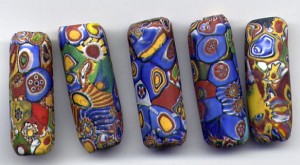It’s hard to believe there are many revolutionary inventions that have altered traditional glass bead production. After all, what more do you need other than a furnace, some bits of glass and a metal rod? Believe it or not, it was the discovery of a new type of rod (mandrel) that transformed Venetian Millefiori Beads from the 1920s onwards. Prior to the discovery, Venetian Trade Beads had been traditionally manufactured using a metal mandrel coated in a white paste (known as a “bead release”) – usually clay or borum nitride. This is evident in nearly all Millefiori Beads produced in the 19th Century, which have a distinctive, powdery white residue in and around the perforation hole.
Father and son glass-making firm Moretti were one of the powerhouses of Venice during the 19th Century. It is they whom are credited with reviving the ancient Roman technique of mosaic glass-making in Italy, and who also discovered that copper was a cost-reducing, efficient alternative to iron and steel for mandrels. At the time, it was considered a landmark discovery, because it required no prior preparation (unlike borum nitride and clay) and it could be found in quantitative supply throughout Europe.
Environmental laws have had a considerable impact on the glass-making industry. Back in the 1920s, there were no regulations in place governing the use of corrosive acids in industrial production, so glass-makers could use Nitric Acid to dissolve the copper within beads after firing. While the toxicity of the fumes cannot be disputed, there was no evidence at the time to suggest such fumes were responsible for terminal illness – so glass-makers were none the wiser.
Environmental awareness and climate change have forced many industries to revise and refine their production techniques. Glass-makers were forced to invest in expense filtering equipment to reduce the toxicity of fumes being emitted into the air, and copper mandrels soon became far too expensive to use in every day production; eventually being replaced with stainless steel.

